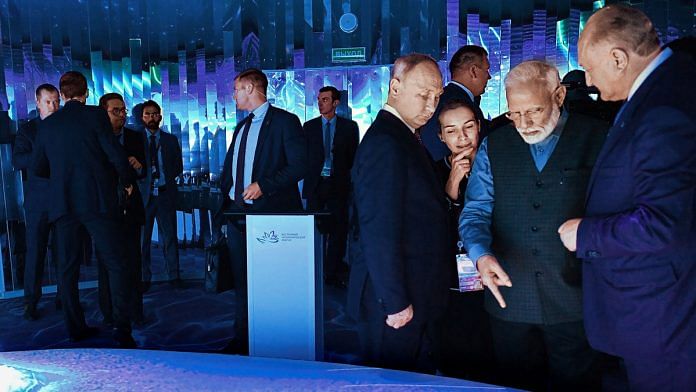New Delhi: Prime Minister Narendra Modi announced an “unprecedented” $1 billion line of credit for Russia’s resource-rich Far East Thursday.
The region, blessed with oil, natural gas and other minerals, comprises nearly 40 per cent of Russian territory, but is sparsely populated.
As a region with plenty of resources and a gateway to the northern Pacific, the Russian Far East has emerged as a major strategic region.
ThePrint takes a look at the Russian Far East, its geopolitical importance for Moscow, New Delhi and other Asian powers.
What is Russian Far East?
The Far East comprises the eastern most part of the Russian Federation that extend from Lake Baikal in Siberia and the Pacific Ocean.
The area comes under the Far Eastern Federal District — the largest of the nine Russian federal districts, but is the least populated one. According to 2010 Census, the district had a population of just over 8 million.
The region’s climatic conditions will explain the reason for a sparse population. While the southern part of the Far East still has liveable climate, with cold winters and hot and humid summers, the northern part experiences Arctic-Siberian-like climatic conditions, which makes it almost uninhabitable.
Also read: Modi and Putin tell the world India and Russia still need each other
Its strategic importance
The Far East assumes special strategic significance for two reasons.
“The geopolitical significance of the RFE rests on its natural wealth — oil, natural gas, coal, gold, diamonds, rare Earth metals and the like — and on its strategic situation in the North Pacific, where the interests of several major powers intersect,” Rensselaer Lee, co-author of Russia’s Far East: New Dynamics in Asia Pacific and Beyond, told the House Foreign Affairs Subcommittee in 2013.
Although traditionally thought of as a European and Central Asian power, the Russian Far East increases Moscow’s stakes in the Asia-Pacific region. It allows Russia to integrate itself in the Indo-Pacific economy and have a military presence in the region.
Putin’s push to develop the Far East
Russian President Vladimir Putin has made a serious push to facilitate development in the Far East.
“While in the 1990s, Moscow almost completely neglected the Russian Far East, under Vladimir Putin, the central government began to reassert its influence, including in the area of the region’s external links,” write strategic scholars Artyom Lukin and Tamara Troyakova.
According to a Bloomberg report, Putin’s Far East development strategy involved setting up a state corporation to “speed up the region’s development”, creating “tax-free zones” and “free ports”, and forcing state-controlled corporations “to take more of an interest in the Far East”.
In addition, Putin has also been organising the Eastern Economic Forum in Vladivostok to bring foreign investments in the region.
According to Putin, the region has seen substantial increase in industrial output and “private sector” investments. But the progress has not been fast enough to temper down some of the region’s historic grievances with Moscow.
This was evident when two of the Kremlin-backed candidates lost in the gubernatorial elections in two of the Far East’s largest regions.
Also read: After Modi-Putin meet, Russia scouts for private Indian players to make defence spares
Asian geopolitics
It is important to view the Russian Far East in a historical context. The region is considered to be one of the two parts of the broader Manchuria. While the Russian Far East is considered as Outer Manchuria, the southern part is called Inner Manchuria.
The present day Inner Manchuria comprises three Chinese provinces and, in stark contrast to Russian Far East, has a population of over 100 million.
Perceptions of growing immigration from Chinese northeastern provinces to the Far East has caused some tensions between Moscow and Beijing, but they have managed to sort it out.
Historically, border and territorial disputes have been a recurring feature in Manchuria and have often led to interstate conflicts. Thus, some strategic scholars think that in the long-run, China’s wish to dominate the Russian Far East can become a contentious issue between Beijing and Moscow.
Looking beyond the Russian-Chinese competition in the Far East, regional powers such as Japan, South Korea and India have shown their interest in helping to develop the region. Several connectivity and infrastructure projects are being proposed, which aim to transform the region into a vibrant economic sphere.
Why is Far East important to India?
India was one of the first Asian powers to recognise the strategic importance of the Far East, and PM Modi made it a point to highlight this when he mentioned that India was the first country to open a consulate in Vladivostok in 1992.
Going ahead, New Delhi could benefit by securing minerals for its developing economy and also establish its presence in the emerging geostrategic region.
Modi also announced that a sea link would be facilitated between Vladivostok and Chennai — which would help reduce the shipping time from 40 to 24 days. Passing through the South China Sea, this sea link would allow India to deepen its presence in the Chinese-dominated South China Sea.
Also read: India to receive Russian S-400 Triumf missiles by 2023, despite threat of US sanctions



